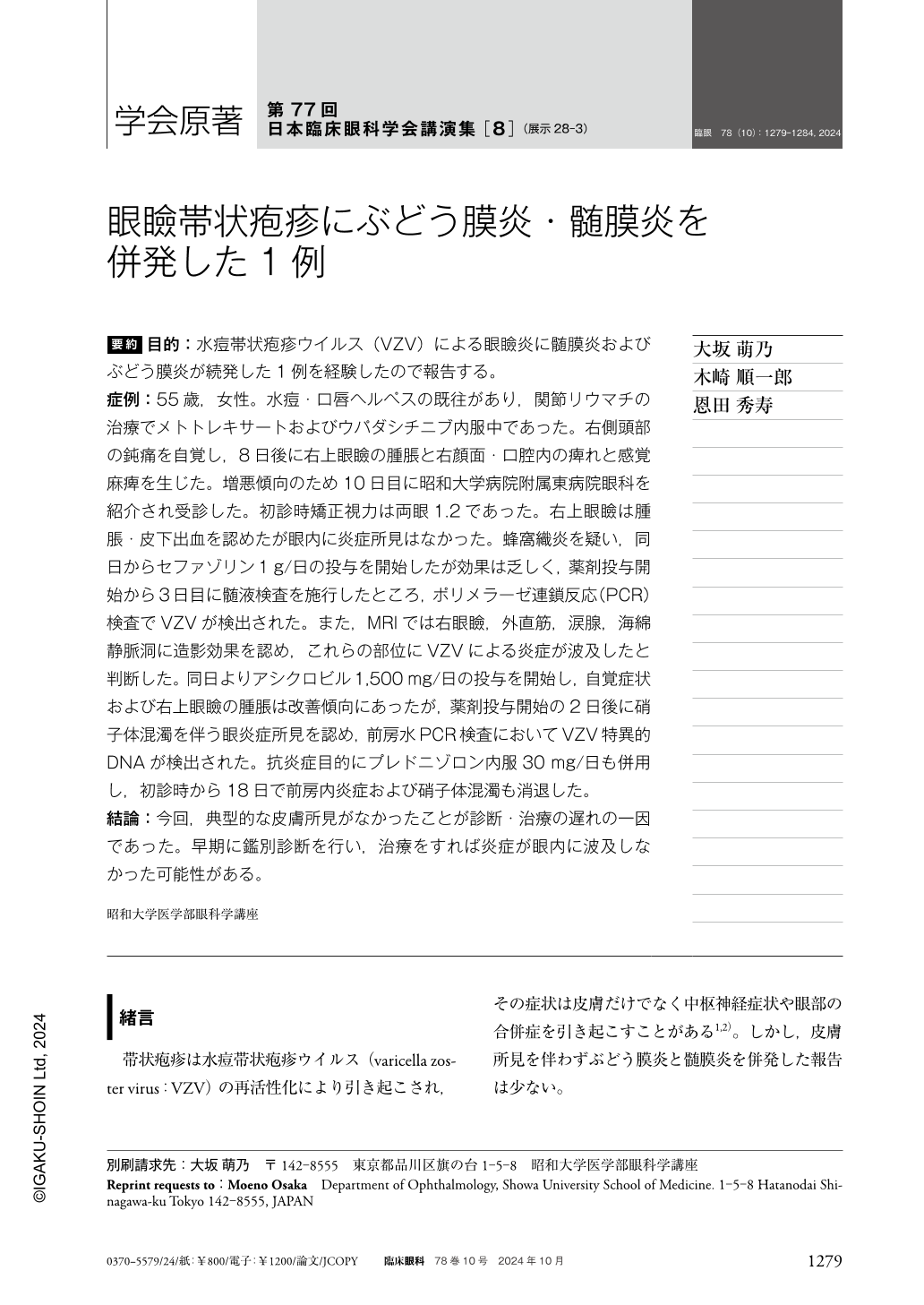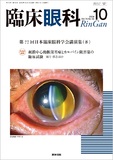Japanese
English
- 有料閲覧
- Abstract 文献概要
- 1ページ目 Look Inside
- 参考文献 Reference
要約 目的:水痘帯状疱疹ウイルス(VZV)による眼瞼炎に髄膜炎およびぶどう膜炎が続発した1例を経験したので報告する。
症例:55歳,女性。水痘・口唇ヘルペスの既往があり,関節リウマチの治療でメトトレキサートおよびウパダシチニブ内服中であった。右側頭部の鈍痛を自覚し,8日後に右上眼瞼の腫脹と右顔面・口腔内の痺れと感覚麻痺を生じた。増悪傾向のため10日目に昭和大学病院附属東病院眼科を紹介され受診した。初診時矯正視力は両眼1.2であった。右上眼瞼は腫脹・皮下出血を認めたが眼内に炎症所見はなかった。蜂窩織炎を疑い,同日からセファゾリン1g/日の投与を開始したが効果は乏しく,薬剤投与開始から3日目に髄液検査を施行したところ,ポリメラーゼ連鎖反応(PCR)検査でVZVが検出された。また,MRIでは右眼瞼,外直筋,涙腺,海綿静脈洞に造影効果を認め,これらの部位にVZVによる炎症が波及したと判断した。同日よりアシクロビル1,500mg/日の投与を開始し,自覚症状および右上眼瞼の腫脹は改善傾向にあったが,薬剤投与開始の2日後に硝子体混濁を伴う眼炎症所見を認め,前房水PCR検査においてVZV特異的DNAが検出された。抗炎症目的にプレドニゾロン内服30mg/日も併用し,初診時から18日で前房内炎症および硝子体混濁も消退した。
結論:今回,典型的な皮膚所見がなかったことが診断・治療の遅れの一因であった。早期に鑑別診断を行い,治療をすれば炎症が眼内に波及しなかった可能性がある。
Abstract Purpose:We report a case of eyelid inflammation, meningitis, and uveitis caused by the varicella zoster virus(VZV).
Case:The patient was a 55-year-old woman with a history of chickenpox and oral herpes, currently being treated for rheumatoid arthritis with methotrexate and upadacitinib. She noticed a dull pain in the right side of her head. Eight days later, she developed swelling of the upper right eyelid, along with numbness and sensory impairment in the right facial area and oral cavity. On the tenth day, she was referred to our hospital for further evaluation and treatment. Her initial corrected visual acuity was 1.2 in both eyes. The right upper eyelid exhibited swelling and internal bleeding, but there were no signs of intraocular inflammation. We suspected that the inflammation was due to cellulitis and started the patient on 1 g of cefazolin. However, antibiotic therapy it had no effect, so we performed cerebrospinal fluid(CSF)test. Cell count in the CSF was found to be elevated, and VZV was detected through polymerase chain reaction(PCR). Magnetic resonance imaging(MRI)revealed contrast enhancement in the right eyelid, lateral rectus muscle, lacrimal gland, and cavernous sinus, indicating the spread of inflammation caused by VZV to these areas. We therefore started treatment with 1.5 g aciclovir. However, two days after the initiation of antiviral therapy, ocular inflammation with vitreous opacity was observed, and VZV was detected in the anterior chamber fluid through PCR. Oral prednisolone(30 mg/day)was also administered for anti-inflammatory purposes, and the anterior chamber inflammation and vitreous opacification disappeared 18 days after the first visit.
Conclusion:The lack of typical skin findings was one of the reasons for the delay in diagnosis and treatment. If a differential diagnosis and treatment were made early, the inflammation may not have spread to the eye.

Copyright © 2024, Igaku-Shoin Ltd. All rights reserved.


